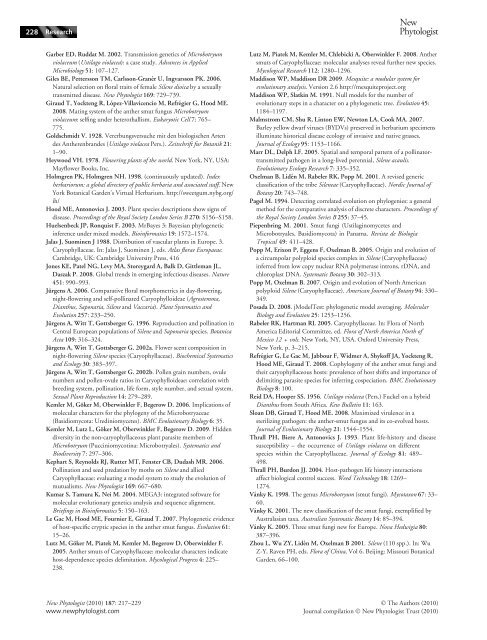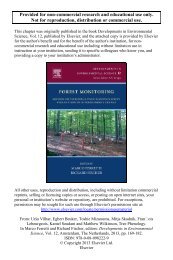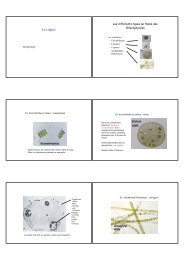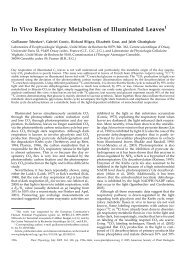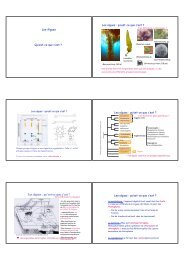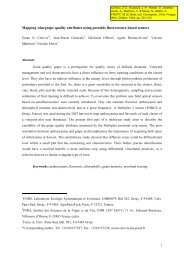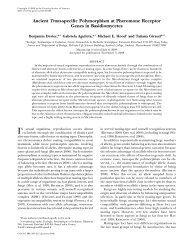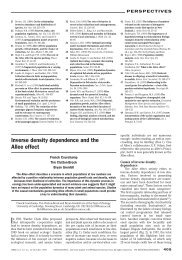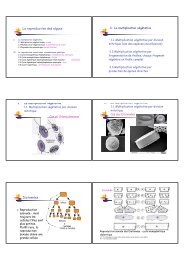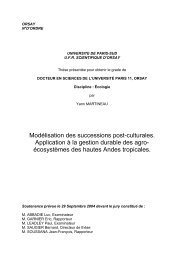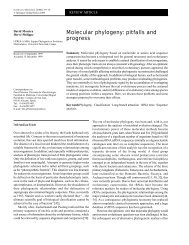Distribution of the anthersmut pathogen Microbotryum on species of ...
Distribution of the anthersmut pathogen Microbotryum on species of ...
Distribution of the anthersmut pathogen Microbotryum on species of ...
You also want an ePaper? Increase the reach of your titles
YUMPU automatically turns print PDFs into web optimized ePapers that Google loves.
228 ResearchNewPhytologistGarber ED, Ruddat M. 2002. Transmissi<strong>on</strong> genetics <str<strong>on</strong>g>of</str<strong>on</strong>g> <str<strong>on</strong>g>Microbotryum</str<strong>on</strong>g>violaceum (Ustilago violacea): a case study. Advances in AppliedMicrobiology 51: 107–127.Giles BE, Petterss<strong>on</strong> TM, Carlss<strong>on</strong>-Granér U, Ingvarss<strong>on</strong> PK. 2006.Natural selecti<strong>on</strong> <strong>on</strong> floral traits <str<strong>on</strong>g>of</str<strong>on</strong>g> female Silene dioica by a sexuallytransmitted disease. New Phytologist 169: 729–739.Giraud T, Yockteng R, López-Villavicencio M, Refrégier G, Hood ME.2008. Mating system <str<strong>on</strong>g>of</str<strong>on</strong>g> <str<strong>on</strong>g>the</str<strong>on</strong>g> an<str<strong>on</strong>g>the</str<strong>on</strong>g>r smut fungus <str<strong>on</strong>g>Microbotryum</str<strong>on</strong>g>violaceum: selfing under heterothallism. Eukaryotic Cell 7: 765–775.Goldschmidt V. 1928. Vererbungsversuche mit den biologischen Artendes An<str<strong>on</strong>g>the</str<strong>on</strong>g>renbrandes (Ustilago violacea Pers.). Zeitschrift fur Botanik 21:1–90.Heywood VH. 1978. Flowering plants <str<strong>on</strong>g>of</str<strong>on</strong>g> <str<strong>on</strong>g>the</str<strong>on</strong>g> world. New York, NY, USA:Mayflower Books, Inc.Holmgren PK, Holmgren NH. 1998. (c<strong>on</strong>tinuously updated). Indexherbariorum: a global directory <str<strong>on</strong>g>of</str<strong>on</strong>g> public herbaria and associated staff. NewYork Botanical Garden’s Virtual Herbarium. http://sweetgum.nybg.org/ih/Hood ME, Ant<strong>on</strong>ovics J. 2003. Plant <strong>species</strong> descripti<strong>on</strong>s show signs <str<strong>on</strong>g>of</str<strong>on</strong>g>disease. Proceedings <str<strong>on</strong>g>of</str<strong>on</strong>g> <str<strong>on</strong>g>the</str<strong>on</strong>g> Royal Society L<strong>on</strong>d<strong>on</strong> Series B 270: S156–S158.Huelsenbeck JP, R<strong>on</strong>quist F. 2003. MrBayes 3: Bayesian phylogeneticinference under mixed models. Bioinformatics 19: 1572–1574.Jalas J, Suominen J 1988. <str<strong>on</strong>g>Distributi<strong>on</strong></str<strong>on</strong>g> <str<strong>on</strong>g>of</str<strong>on</strong>g> vascular plants in Europe. 3.Caryophyllaceae. In: Jalas J, Suominen J, eds. Atlas florae Europaeae.Cambridge, UK: Cambridge University Press, 416J<strong>on</strong>es KE, Patel NG, Levy MA, Storeygard A, Balk D, Gittleman JL,Daszak P. 2008. Global trends in emerging infectious diseases. Nature451: 990–993.Jürgens A. 2006. Comparative floral morphometrics in day-flowering,night-flowering and self-pollinated Caryophylloideae (Agrostemma,Dianthus, Sap<strong>on</strong>aria, Silene and Vaccaria). Plant Systematics andEvoluti<strong>on</strong> 257: 233–250.Jürgens A, Witt T, Gottsberger G. 1996. Reproducti<strong>on</strong> and pollinati<strong>on</strong> inCentral European populati<strong>on</strong>s <str<strong>on</strong>g>of</str<strong>on</strong>g> Silene and Sap<strong>on</strong>aria <strong>species</strong>. BotanicaActa 109: 316–324.Jürgens A, Witt T, Gottsberger G. 2002a. Flower scent compositi<strong>on</strong> innight-flowering Silene <strong>species</strong> (Caryophyllaceae). Biochemical Systematicsand Ecology 30: 383–397.Jürgens A, Witt T, Gottsberger G. 2002b. Pollen grain numbers, ovulenumbers and pollen-ovule ratios in Caryophylloideae: correlati<strong>on</strong> withbreeding system, pollinati<strong>on</strong>, life form, style number, and sexual system.Sexual Plant Reproducti<strong>on</strong> 14: 279–289.Kemler M, Göker M, Oberwinkler F, Begerow D. 2006. Implicati<strong>on</strong>s <str<strong>on</strong>g>of</str<strong>on</strong>g>molecular characters for <str<strong>on</strong>g>the</str<strong>on</strong>g> phylogeny <str<strong>on</strong>g>of</str<strong>on</strong>g> <str<strong>on</strong>g>the</str<strong>on</strong>g> Microbotryaceae(Basidiomycota: Urediniomycetes). BMC Evoluti<strong>on</strong>ary Biology 6: 35.Kemler M, Lutz L, Göker M, Oberwinkler F, Begerow D. 2009. Hiddendiversity in <str<strong>on</strong>g>the</str<strong>on</strong>g> n<strong>on</strong>-caryophyllaceous plant parasite members <str<strong>on</strong>g>of</str<strong>on</strong>g><str<strong>on</strong>g>Microbotryum</str<strong>on</strong>g> (Pucciniomycotina: Microbotryales). Systematics andBiodiversity 7: 297–306.Kephart S, Reynolds RJ, Rutter MT, Fenster CB, Dudash MR. 2006.Pollinati<strong>on</strong> and seed predati<strong>on</strong> by moths <strong>on</strong> Silene and alliedCaryophyllaceae: evaluating a model system to study <str<strong>on</strong>g>the</str<strong>on</strong>g> evoluti<strong>on</strong> <str<strong>on</strong>g>of</str<strong>on</strong>g>mutualisms. New Phytologist 169: 667–680.Kumar S, Tamura K, Nei M. 2004. MEGA3: integrated s<str<strong>on</strong>g>of</str<strong>on</strong>g>tware formolecular evoluti<strong>on</strong>ary genetics analysis and sequence alignment.Briefings in Bioinformatics 5: 150–163.Le Gac M, Hood ME, Fournier E, Giraud T. 2007. Phylogenetic evidence<str<strong>on</strong>g>of</str<strong>on</strong>g> host-specific cryptic <strong>species</strong> in <str<strong>on</strong>g>the</str<strong>on</strong>g> an<str<strong>on</strong>g>the</str<strong>on</strong>g>r smut fungus. Evoluti<strong>on</strong> 61:15–26.Lutz M, Göker M, Piatek M, Kemler M, Begerow D, Oberwinkler F.2005. An<str<strong>on</strong>g>the</str<strong>on</strong>g>r smuts <str<strong>on</strong>g>of</str<strong>on</strong>g> Caryophyllaceae: molecular characters indicatehost-dependence <strong>species</strong> delimitati<strong>on</strong>. Mycological Progress 4: 225–238.Lutz M, Piatek M, Kemler M, Chlebicki A, Oberwinkler F. 2008. An<str<strong>on</strong>g>the</str<strong>on</strong>g>rsmuts <str<strong>on</strong>g>of</str<strong>on</strong>g> Caryophyllaceae: molecular analyses reveal fur<str<strong>on</strong>g>the</str<strong>on</strong>g>r new <strong>species</strong>.Mycological Research 112: 1280–1296.Maddis<strong>on</strong> WP, Maddis<strong>on</strong> DR 2009. Mesquite: a modular system forevoluti<strong>on</strong>ary analysis. Versi<strong>on</strong> 2.6 http://mesquiteproject.orgMaddis<strong>on</strong> WP, Slatkin M. 1991. Null models for <str<strong>on</strong>g>the</str<strong>on</strong>g> number <str<strong>on</strong>g>of</str<strong>on</strong>g>evoluti<strong>on</strong>ary steps in a character <strong>on</strong> a phylogenetic tree. Evoluti<strong>on</strong> 45:1184–1197.Malmstrom CM, Shu R, Lint<strong>on</strong> EW, Newt<strong>on</strong> LA, Cook MA. 2007.Barley yellow dwarf viruses (BYDVs) preserved in herbarium specimensilluminate historical disease ecology <str<strong>on</strong>g>of</str<strong>on</strong>g> invasive and native grasses.Journal <str<strong>on</strong>g>of</str<strong>on</strong>g> Ecology 95: 1153–1166.Marr DL, Delph LF. 2005. Spatial and temporal pattern <str<strong>on</strong>g>of</str<strong>on</strong>g> a pollinatortransmitted<str<strong>on</strong>g>pathogen</str<strong>on</strong>g> in a l<strong>on</strong>g-lived perennial, Silene acaulis.Evoluti<strong>on</strong>ary Ecology Research 7: 335–352.Oxelman B, Lidén M, Rabeler RK, Popp M. 2001. A revised genericclassificati<strong>on</strong> <str<strong>on</strong>g>of</str<strong>on</strong>g> <str<strong>on</strong>g>the</str<strong>on</strong>g> tribe Sileneae (Caryophyllaceae). Nordic Journal <str<strong>on</strong>g>of</str<strong>on</strong>g>Botany 20: 743–748.Pagel M. 1994. Detecting correlated evoluti<strong>on</strong> <strong>on</strong> phylogenies: a generalmethod for <str<strong>on</strong>g>the</str<strong>on</strong>g> comparative analysis <str<strong>on</strong>g>of</str<strong>on</strong>g> discrete characters. Proceedings <str<strong>on</strong>g>of</str<strong>on</strong>g><str<strong>on</strong>g>the</str<strong>on</strong>g> Royal Society L<strong>on</strong>d<strong>on</strong> Series B 255: 37–45.Piepenbring M. 2001. Smut fungi (Ustilaginomycetes andMicrobotryales, Basidiomycota) in Panama. Revista de BiologíaTropical 49: 411–428.Popp M, Erix<strong>on</strong> P, Eggens F, Oxelman B. 2005. Origin and evoluti<strong>on</strong> <str<strong>on</strong>g>of</str<strong>on</strong>g>a circumpolar polyploid <strong>species</strong> complex in Silene (Caryophyllaceae)inferred from low copy nuclear RNA polymerase intr<strong>on</strong>s, rDNA, andchloroplast DNA. Systematic Botany 30: 302–313.Popp M, Oxelman B. 2007. Origin and evoluti<strong>on</strong> <str<strong>on</strong>g>of</str<strong>on</strong>g> North Americanpolyploid Silene (Caryophyllaceae). American Journal <str<strong>on</strong>g>of</str<strong>on</strong>g> Botany 94: 330–349.Posada D. 2008. jModelTest: phylogenetic model averaging. MolecularBiology and Evoluti<strong>on</strong> 25: 1253–1256.Rabeler RK, Hartman RL 2005. Caryophyllaceae. In: Flora <str<strong>on</strong>g>of</str<strong>on</strong>g> NorthAmerica Editorial Committee, ed. Flora <str<strong>on</strong>g>of</str<strong>on</strong>g> North America North <str<strong>on</strong>g>of</str<strong>on</strong>g>Mexico 12 + vols. New York, NY, USA. Oxford University Press,New York. p. 3–215.Refrégier G, Le Gac M, Jabbour F, Widmer A, Shyk<str<strong>on</strong>g>of</str<strong>on</strong>g>f JA, Yockteng R,Hood ME, Giraud T. 2008. Cophylogeny <str<strong>on</strong>g>of</str<strong>on</strong>g> <str<strong>on</strong>g>the</str<strong>on</strong>g> an<str<strong>on</strong>g>the</str<strong>on</strong>g>r smut fungi and<str<strong>on</strong>g>the</str<strong>on</strong>g>ir caryophyllaceous hosts: prevalence <str<strong>on</strong>g>of</str<strong>on</strong>g> host shifts and importance <str<strong>on</strong>g>of</str<strong>on</strong>g>delimiting parasite <strong>species</strong> for inferring cospeciati<strong>on</strong>. BMC Evoluti<strong>on</strong>aryBiology 8: 100.Reid DA, Hooper SS. 1956. Ustilago violacea (Pers.) Fuckel <strong>on</strong> a hybridDianthus from South Africa. Kew Bulletin 11: 163.Sloan DB, Giraud T, Hood ME. 2008. Maximized virulence in asterilizing <str<strong>on</strong>g>pathogen</str<strong>on</strong>g>: <str<strong>on</strong>g>the</str<strong>on</strong>g> an<str<strong>on</strong>g>the</str<strong>on</strong>g>r-smut fungus and its co-evolved hosts.Journal <str<strong>on</strong>g>of</str<strong>on</strong>g> Evoluti<strong>on</strong>ary Biology 21: 1544–1554.Thrall PH, Biere A, Ant<strong>on</strong>ovics J. 1993. Plant life-history and diseasesusceptibility – <str<strong>on</strong>g>the</str<strong>on</strong>g> occurrence <str<strong>on</strong>g>of</str<strong>on</strong>g> Ustilago violacea <strong>on</strong> different<strong>species</strong> within <str<strong>on</strong>g>the</str<strong>on</strong>g> Caryophyllaceae. Journal <str<strong>on</strong>g>of</str<strong>on</strong>g> Ecology 81: 489–498.Thrall PH, Burd<strong>on</strong> JJ. 2004. Host-<str<strong>on</strong>g>pathogen</str<strong>on</strong>g> life history interacti<strong>on</strong>saffect biological c<strong>on</strong>trol success. Weed Technology 18: 1269–1274.Vánky K. 1998. The genus <str<strong>on</strong>g>Microbotryum</str<strong>on</strong>g> (smut fungi). Mycotax<strong>on</strong> 67: 33–60.Vánky K. 2001. The new classificati<strong>on</strong> <str<strong>on</strong>g>of</str<strong>on</strong>g> <str<strong>on</strong>g>the</str<strong>on</strong>g> smut fungi, exemplified byAustralasian taxa. Australian Systematic Botany 14: 85–394.Vánky K. 2005. Three smut fungi new for Europe. Nova Hedwigia 80:387–396.Zhou L, Wu ZY, Lidén M, Oxelman B 2001. Silene (110 spp.). In: WuZ-Y, Raven PH, eds. Flora <str<strong>on</strong>g>of</str<strong>on</strong>g> China, Vol 6. Beijing: Missouri BotanicalGarden, 66–100.New Phytologist (2010) 187: 217–229www.newphytologist.comÓ The Authors (2010)Journal compilati<strong>on</strong> Ó New Phytologist Trust (2010)


